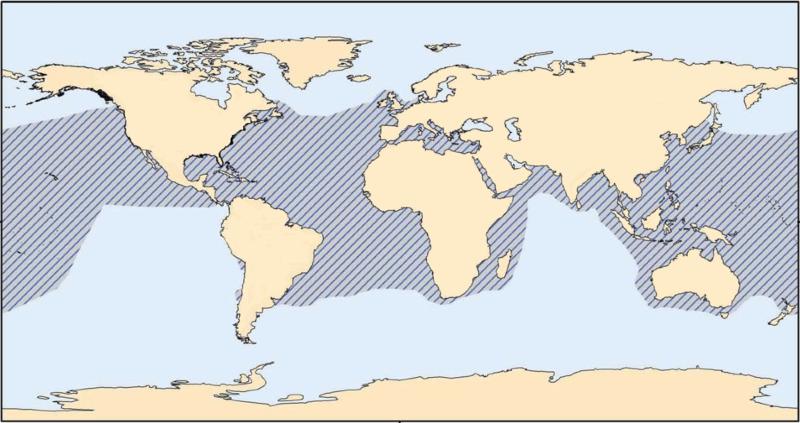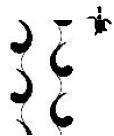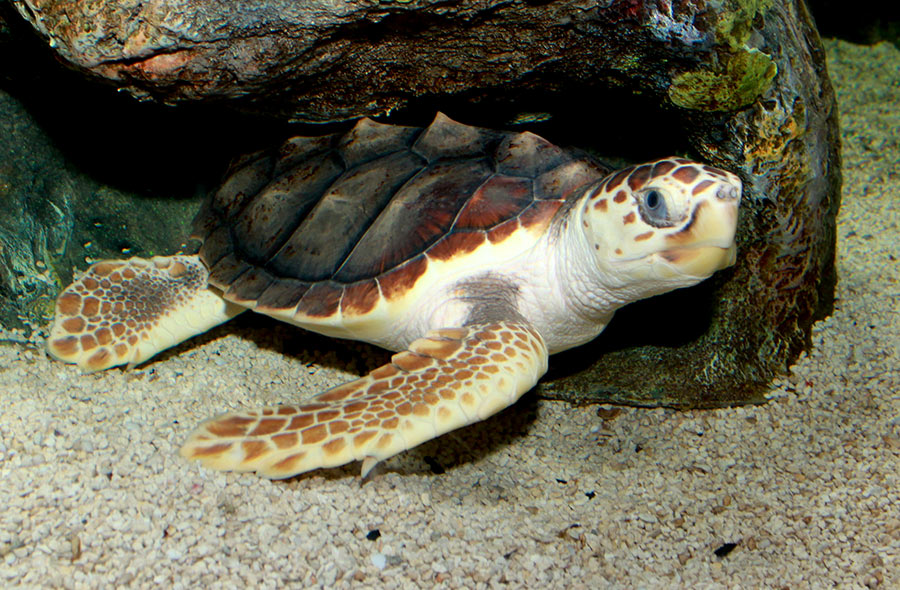Loggerhead (Caretta caretta)
Common Name:
Loggerhead – named for its exceptionally large head.
Scientific Name:
Caretta caretta
Description:
Head is very large with heavy strong jaws. Carapace is bony without ridges and has large, non-overlapping, rough scutes (scales) present with 5 lateral scute. Carapace is heart shaped. Front flippers are short and thick with 2 claws, while the rear flippers can have 2 or 3 claws. Carapace is a reddish-brown with a yellowish-brown plastron. Hatchlings have a dark-brown carapace with flippers pale brown on margins.
Size/Weight/Age:
The Loggerhead measures up to 1.1 meters (3.5 ft) long when fully grown, weighing approximately 135 kilograms (300 lb) and have a lifespan of 47-67 years.
Diet:
The Loggerhead Sea Turtle is omnivorous, feeding mainly on bottom dwelling invertebrates: mollusks, crustaceans, horseshoe crabs, clams, mussels, and other marine animals. Its large and powerful jaw serve as an effective tool in dismantling its prey.
Habitat:
Prefer to feed in coastal bays and estuaries, as well as in the shallow water along the continental shelves of the Atlantic, Pacific and Indian Oceans.

Reproduction:
Female Loggerheads, between the age of 17 to 33, will usually mate every 2 to 4 years.
 Crawl Pattern:
Crawl Pattern:
- Alternating comma-shaped flipper marks
- Wavy and smoothed track center with no thin, straight, and well-defined tail-drag mark
- No regular marking from front flippers at the margins of the track
Nesting:
Female Loggerheads are known to nest from one to seven times within a nesting season (mean is about 4.1 nests per season) at intervals of approximately 12–17 days. Mean clutch size varies from about 100 to 126 along the southeastern United States coast. Incubation ranges from about 45 to 95 days, depending on incubation temperatures, but averages 55 to 60 days for most clutches.
Status:
U.S. – Listed as Threatened (possibility of becoming Endangered within the foreseeable future) under the U.S. Federal Endangered Species Act.
International – Listed as Endangered (facing high risk of extinction in the wild in the immediate future) by the International Union for Conservation of Nature and Natural Resources ( IUCN)
Threats to Survival:
Fishing gear is the biggest threat to loggerheads in the open ocean. They often become entangled in longlines or gillnets. According to the 2009 status review of loggerheads by the Fisheries Service, drowning from entanglement in longline and gillnet fishing gear is the turtles’ primary threat in the North Pacific.
The second greatest threat is loss of nesting habitat due to coastal development, predation of nests, and human disturbances (such as coastal lighting and housing developments) that discourages nesting and interferes with the hatchlings’ ability to navigate to the water’s edge.

